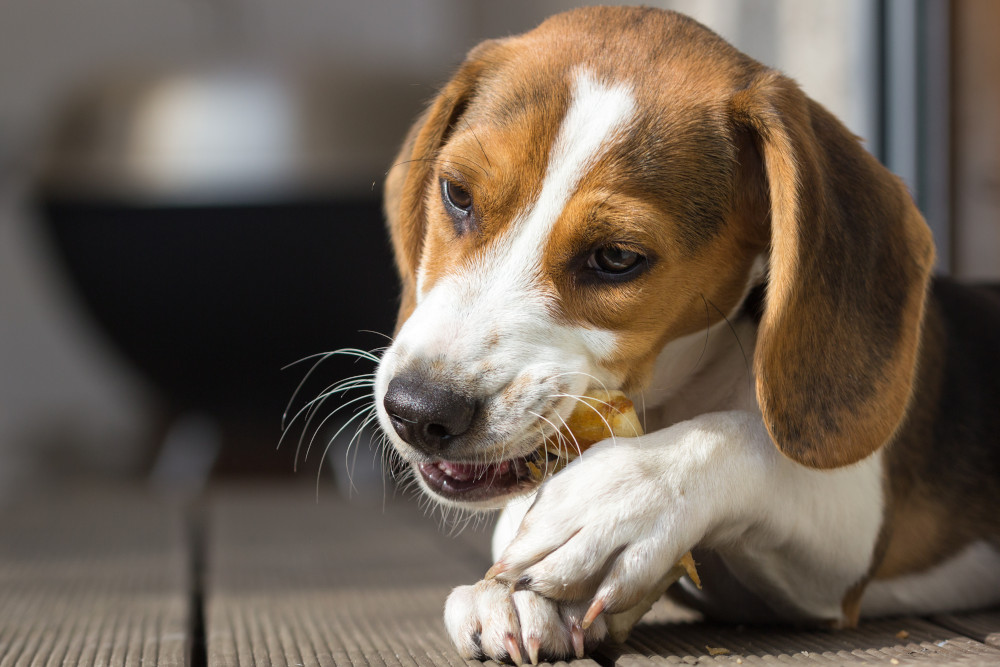
Bones can provide dogs with nutrients and mental stimulation, plus remove tartar from the surface of their teeth. However, bones can break teeth, cause internal blockages, as well as carry bacteria that can make both animals and humans ill. It is important to consider these factors so you can make a well-informed decision that is best for the wellbeing of your pet and family.
The benefits of feeding dog bones
- Bones are a source of dietary nutrients such as protein, calcium, and phosphorus.
- There is evidence that chewing bones can remove tartar from the crown/top of a dog’s teeth [1]. However, this action does not remove tartar present below the gumline or prevent plaque from building up and causing dental disease.
- The chewing activity can provide mental stimulation [2].
The risks of feeding dog bones
- Due to bone’s hard density, chewing on them can result in broken and worn teeth [3, 4]. Sharp ends can also cause wounds to the inside of the mouth and throat. It is recommended that dogs be watched if bones are fed. Never offer cooked bones.
- If large portions of bone are swallowed, they can get stuck in the dog’s gastrointestinal tract [4, 5]. This often results in distress for the pet and family and can require expensive life-saving surgery. Consult a veterinarian promptly if your dog is vomiting, refusing food, showing abdominal pain, or not passing faeces, and alert them that this started after your dog ate a bone.
- Bones, or any raw meat, are likely to be contaminated with bacteria, no matter how well prepared and packaged. Some, but not all, microbes can be killed by freezing for at least two days. The types of bacteria and parasites found in meat can cause disease in humans, as well as animals. If feeding any raw meat including bones, it is important to thoroughly clean hands and any surfaces the meat has touched; bag and bin dog waste that follows a raw or bone meal and wash your hands with soap after its disposal [4, 6].
- Bones alone may not provide an adequate balance of nutrients so, if you choose to feed them, they should only form a small part of your pet’s diet [4, 6]. The diet should be comprised of a high-quality nutritionally complete food.
- Bones often have a lot of fat. A high fat diet can result in inflammation of the pancreas, which can be very painful and potentially very serious. Excess fat may also cause diarrhoea and may contribute to weight gain [4, 7]. To help safeguard against these problems, remove as much fat as possible from the bone(s) before feeding.
- Some dogs can highly value bones and feel a need to guard them. Resource guarding is a normal dog behaviour; however, concern arises if a dog displays signs of aggression towards anyone who gets close to them whilst they possess a bone. Dogs who growl or snap when feeling threatened tend to show high levels of fearfulness throughout their daily life [8], and it is not recommended to feed them bones.
Dogs have evolved significantly from their wolf ancestors, including developing an ability to digest starch and fat, in addition to living longer and healthier lives [4]. Feeding them bones is not necessary given the range of quality nutritionally balanced diets available. Dental chews are a good alternative if you wish to provide your pet with entertainment that assists with teeth cleaning – the global Veterinary Oral Health Council lists dental products that meet standards for safety and reducing plaque/tartar. If you are unsure and want more information, seek appropriate veterinary advice.
References
[1] Marx F et al (2016) Raw beef bones as chewing items to reduce dental calculus in Beagle dogs. Australian Veterinary Journal 94: 18-23.
[2] Ketter DA et al (2020) Effects of calf horn as chews on the behavior of laboratory dogs. Journal of Applied Animal Welfare Science 23: 116-128.
[3] Van Valkenburgh B et al (2019) Tooth fracture frequency in gray wolves reflects prey availability. eLife 8: DOI: 10.7554/eLife.48628.
[4] Freeman LM et al (2013) Current knowledge about the risks and benefits of raw meat-based diets for dogs and cats. Journal of the American Veterinary Medical Association 243: 1549–1558.
[5] Wyatt SR, Barron PM (2019) Complications following removal of oesophageal foreign bodies: a retrospective review of 349 cases. Australian Veterinary Journal 97: 116–121.
[6] Davies RH et al (2019) Raw diets for dogs and cats: a review, with particular reference to microbiological hazards. Journal of Small Animal Practice 60: 329-339.
[7] Neshovska H (2020) The raw dog food – advantages and disadvantages. Tradition and Modernity in Veterinary Medicine 5: 76-87.
[8] Jacobs JA (2018) Factors associated with canine resource guarding behaviour in the presence of people: a cross-sectional survey of dog owners. Preventive Veterinary Medicine 161: 143-153.
